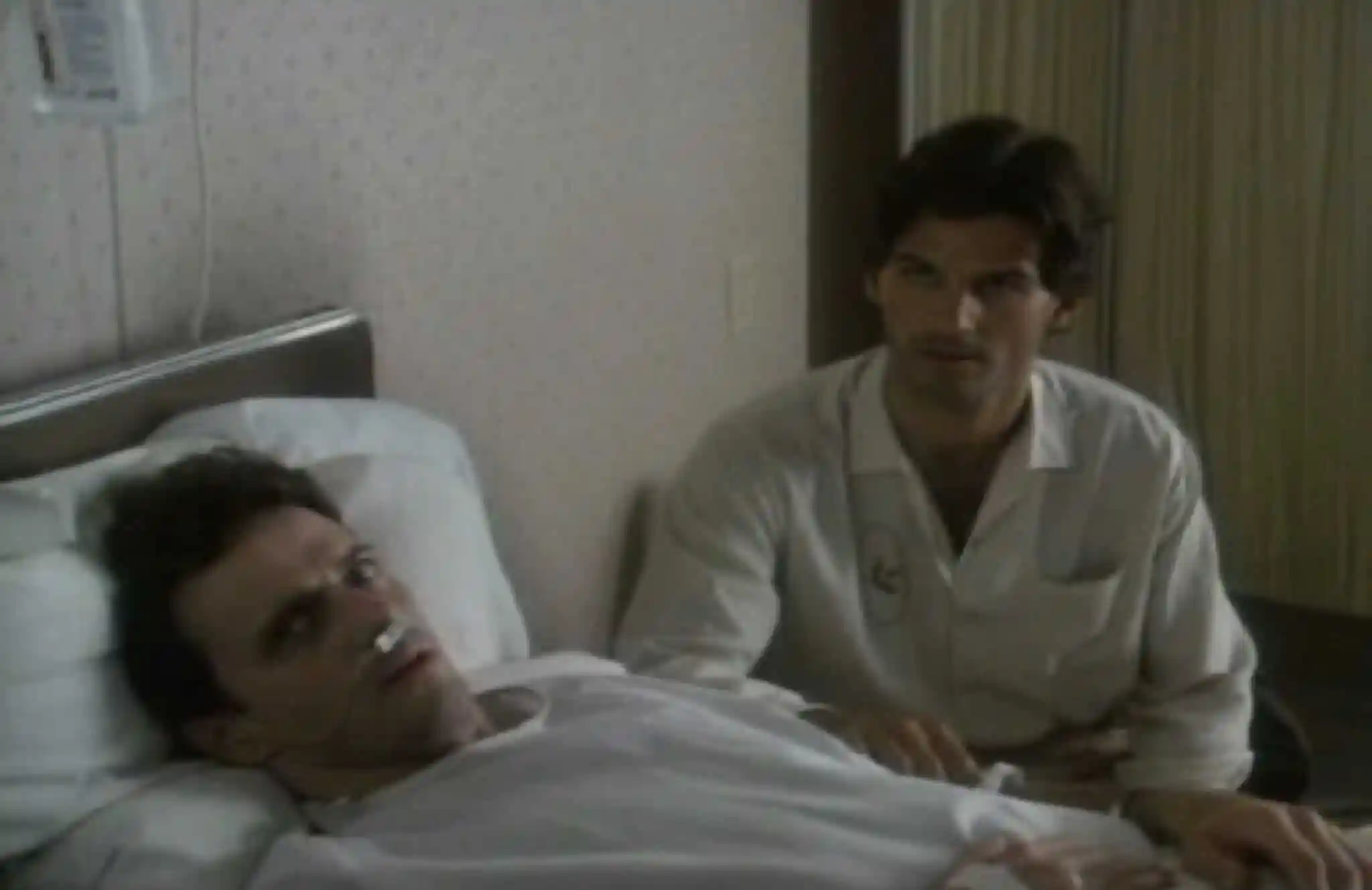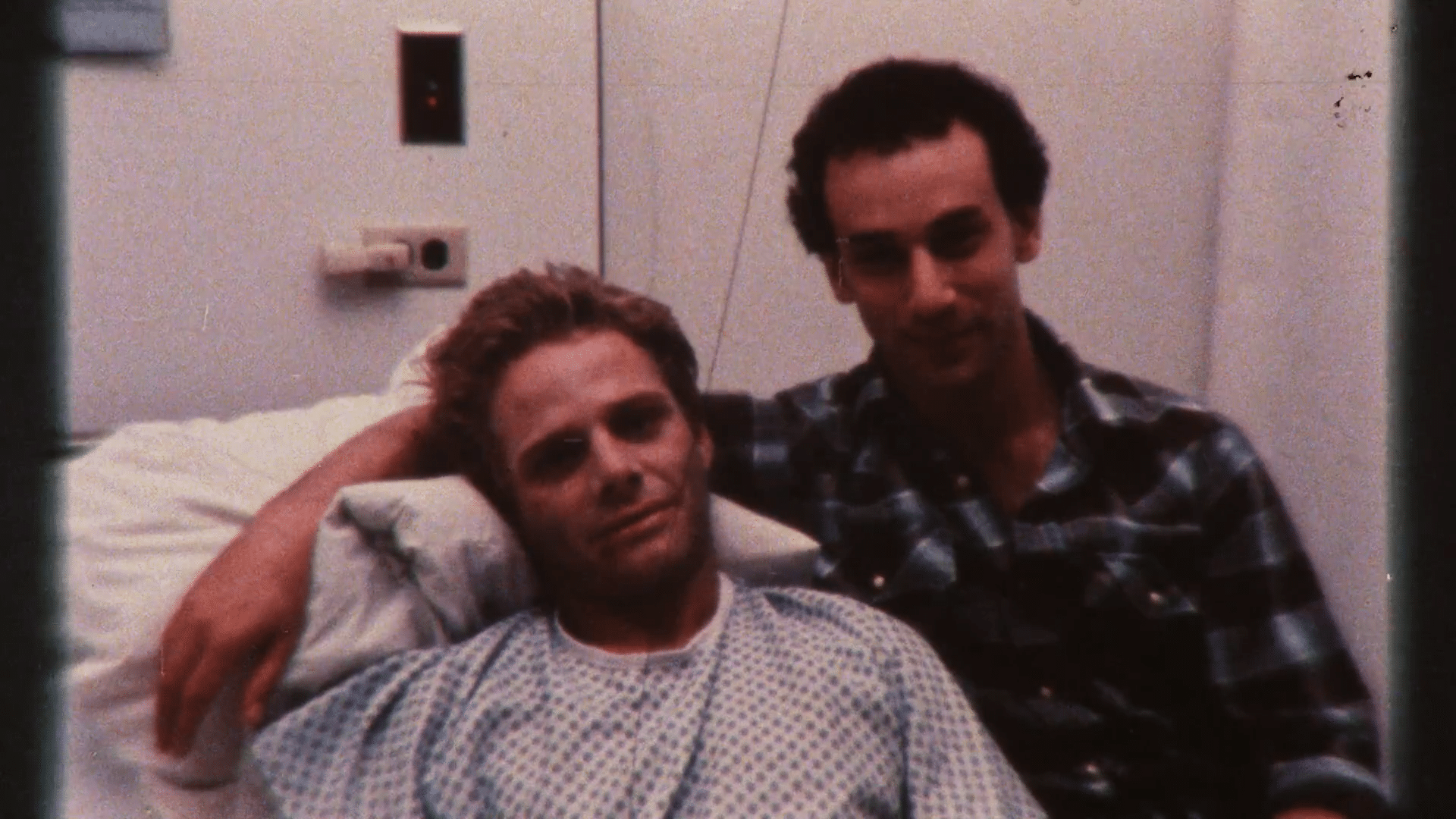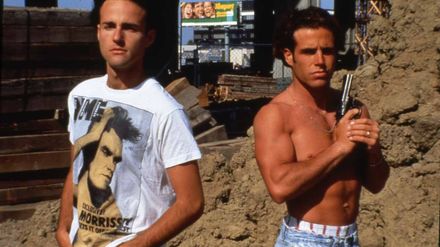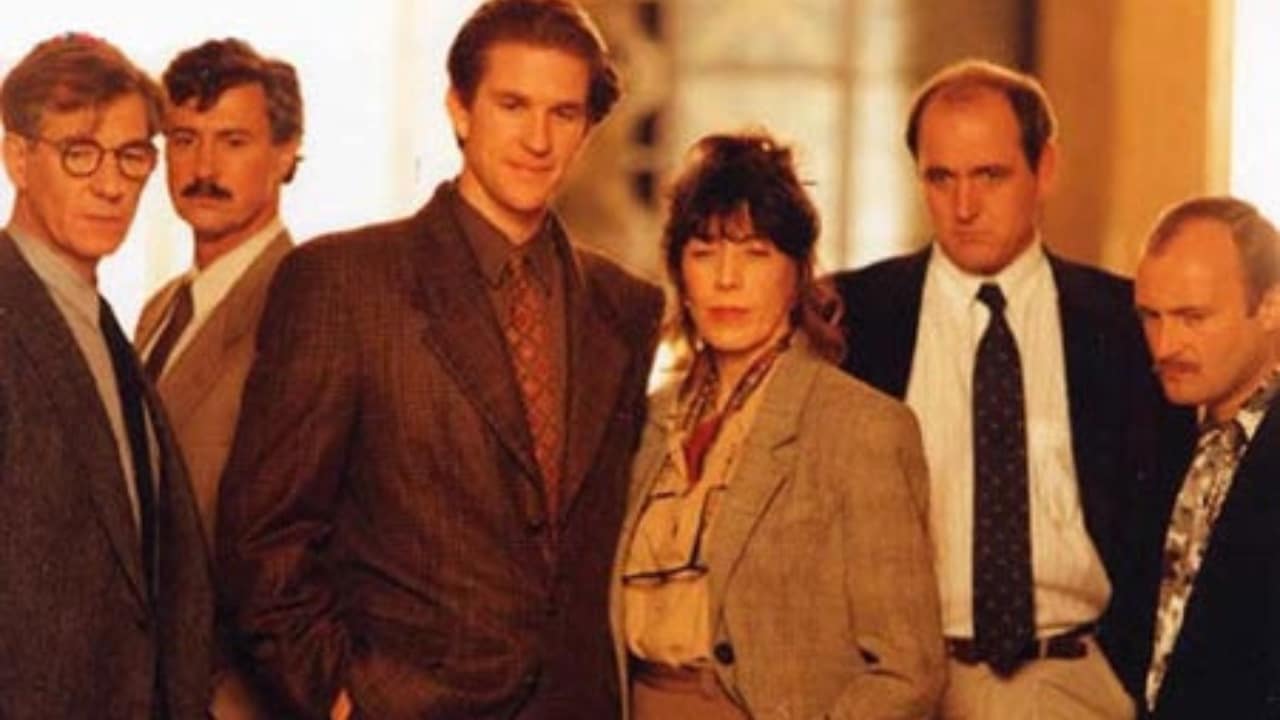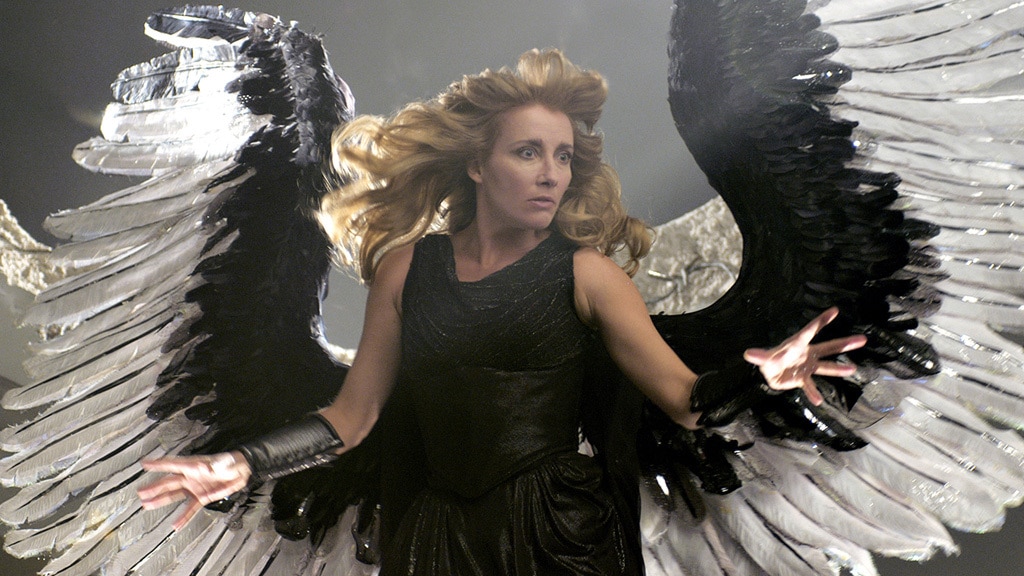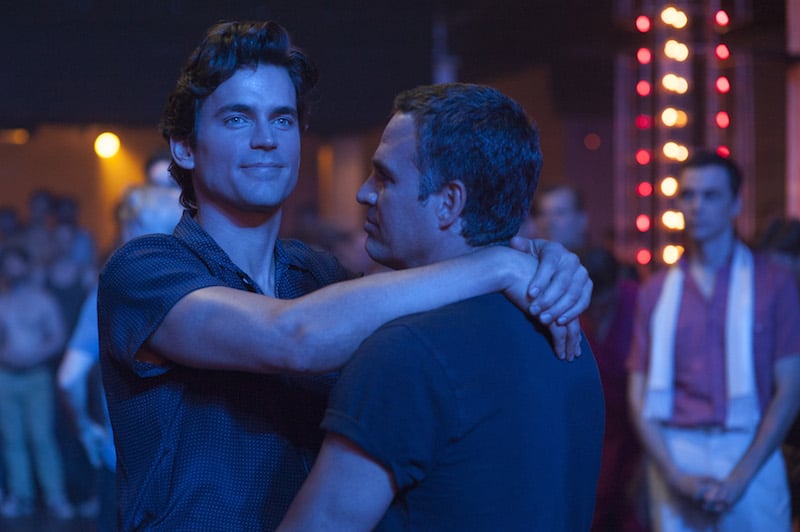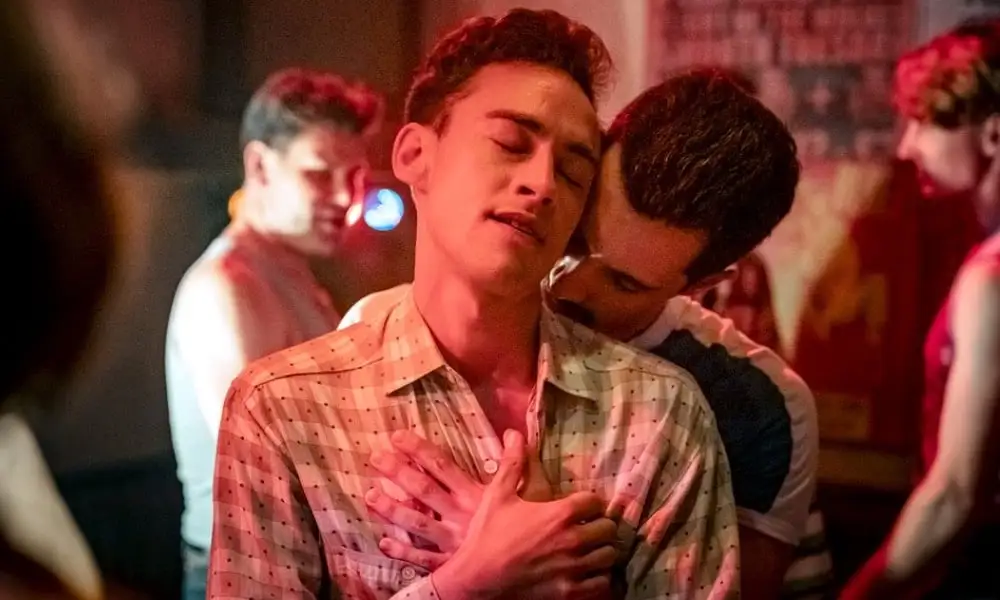The good, the bad and the sometimes ugly history of HIV and AIDS on screen
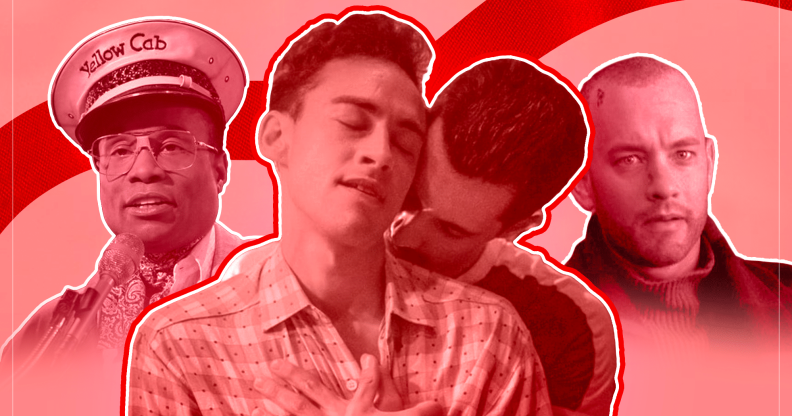
Billy Porter in Pose, Olly Alexander in It’s a Sin and Tom Hanks in Philadelphia. (PinkNews)
In 1993, the film Philadelphia hit cinemas – and it brought HIV and AIDS to the public in a way that had never been seen before.
The AIDS epidemic had already been raging for more than a decade when cinema-goers flocked to see Tom Hanks playing Andrew Beckett, a gay man with HIV who takes legal action against his former employer after he was sacked because of his condition.
Philadelphia has gone down in history as the first major Hollywood film that dealt with the AIDS epidemic – and it’s also notable that it did so in a largely empathetic way. But that film wasn’t the first to tackle HIV, and it certainly wasn’t the last. Over the years, countless filmmakers and television studios have told stories about AIDS – and it’s fair to say that the results have been mixed.
To mark World AIDS Day, we look back on the potted history of HIV representation on screen, starting in the 1980s when the virus first emerged and leading up to the present day.
1. 1985: An Early Frost
In 1985, the AIDS epidemic was still not getting the attention it so badly needed from governments across the world. Misinformation abounded – there was still a great deal of confusion about how the virus was spread. Within the queer community, people were dying – and society appeared to be looking away instead of offering a helping hand.
That year, the made-for-television film An Early Frost aired on NBC. The film was watched by 34 million people and it went on to garner 14 Emmy nominations.
An Early Frost follows Chicago attorney Michael Pierson (Aidan Quinn) as he goes home to tell his parents that he is gay and that he has AIDS. The film touches on some of the discriminatory attitudes people with HIV faced at that time – Michael’s pregnant sister refuses to see him, thinking he poses a risk to her unborn child. His father reacts angrily when Michael tries to kiss his mother. In one of the film’s most heartbreaking scenes, paramedics refuse to bring Michael to hospital because of his HIV status.
An Early Frost was hugely significant when it was released – it debunked some of the myths that were being spread about HIV and also, crucially, didn’t end with its main character dying.
2. 1985: Buddies
The same year as An Early Frost aired on NBC, Arthur J Bressan Jr wrote and directed the film Buddies. It is remembered today as the first film to deal with AIDS and, while it didn’t have quite the same reach as An Early Frost, it won praise for its candid handling of the virus.
Buddies follows a gay man living in New York who becomes a “buddy” to another gay man who is dying from AIDS. The film was shown in arthouse cinemas and it premiered in San Francisco’s Castro Theatre.
Tragically, Bressan Jr died from AIDS related complications just two years after Buddies was released.
3. 1989: Longtime Companion
Longtime Companion is officially the first wide-release theatrical film to have dealt with HIV and AIDS – even if it didn’t have quite the reach or impact of Philadelphia.
The film’s title references The New York Times‘ tendency to refer to the partners of queer men who had died as their “longtime companions”. It chronicles the early years of the AIDS epidemic from the perspectives of gay men and one of their straight friends.
Longtime Companion starts in 1981 and ends in 1989. It gives a comprehensive view of what the first decade of HIV and AIDS was like for queer men of the era.
The film won critical acclaim upon its release, and it’s still considered a classic of queer cinema to this day.
4. 1992: The Living End
The Living End was released in 1992 and has been described as a gay version of Thelma and Louise. The film follows Luke and Jon, two gay men living with HIV who go on a road trip after Luke kills a homophobic police officer.
The film was released to positive reviews, and it was even nominated for the Sundance Film Festival Award – but some critics were unimpressed by its botched nihilistic tones.
The film isn’t as well remembered as some other on-screen depictions of HIV and AIDS – it was a low-budget, independent film that was probably watched more by arthouse film fans than by the general public.
Still, The Living End is revered today as an important film in the history of queer cinema.
5. 1993: Philadelphia
Philadelphia remains one of the most influential on-screen depictions of HIV and AIDS to this day. It won Tom Hanks an Oscar for best actor, and it made waves for its surprisingly progressive depiction of a gay couple.
That’s not to say Philadelphia got everything right – the film was criticised by some when it was released as not being radical enough.
It’s also notable that the film largely focuses on the friendship between Tom Hanks’ character Andrew and Denzel Washington’s lawyer character Joe Miller. Meanwhile, Hanks’ on-screen boyfriend Miguel (Antonio Banderas) is relegated to the background for much of the film. The key artwork for the film also focuses on Hanks and Washington, possibly to make it more palatable to straight audiences.
Despite those issues, Philadelphia was groundbreaking when it was released for bringing HIV and queernees to the masses.
6. 1993: And the Band Played On
The same year that Philadelphia was released, HBO aired a television film called And the Band Played On. The film starred Ian McKellen, Lily Tomlin, Steve Martin, Anjelica Huston, and it quickly garnered a slew of Emmy nominations.
And the Band Played On is based on the non-fiction book of the same name, published in 1987, and it charts the rise of the AIDS epidemic and looks at how in-fighting among researchers slowed progress on combating the virus.
The film helped shine a light on the AIDS epidemic, and demonstrated how inaction meant that the death toll was unforgivably high.
7. 2003: Angels in America
HBO again visited the AIDS epidemic with its miniseries Angels in America, based on the play of the same name by Tony Kushner.
The series became the most watched made-for-cable film of the year, and its cast – which included Al Pacino, Meryl Streep, Patrick Wilson and Emma Thompson – won praise for their performances.
The 2003 adaptation of Angels in America explores Reagan-era politics and looks at the spread of HIV through the queer community in the 1980s. It went on to win a number of Golden Globes and Emmys the following year.
8. 2013: Dallas Buyers Club
By the time Dallas Buyers Club was released in 2013, much had changed in the fight against HIV and AIDS. Effective treatment had become widely available in wealthy countries, meaning HIV was no longer a death sentence.
Dallas Buyers Club won critical acclaim for its focus on the life of Ron Woodroof, played by Matthew McConaughey – but it also attracted criticism for the way it handled Woodroof’s story. The film famously paints Woodroof, who set up a “buyers club” for drugs to treat HIV and AIDS in the 1980s, as a homophobe.
William Waybourn, the former president of the Dallas Gay Alliance, told HuffPost in 2013 that the depiction of Woodroof did not align with the man he knew.
“I never saw the straight side of Ron,” Waybourn said. “That’s what was the most surprising part of this whole movie. He worked in a gay centre, he was surrounded by gay men, and as far as I know, had relationships with gay men. I can’t tell you exactly what his sexual orientation was – or anyone’s – but he certainly had no problems being around us.”
That wasn’t the film’s only misstep – Jared Leto also faced backlash for playing a trans woman with HIV in the film, with many questioning why a trans actor wasn’t considered for the part.
9. 2014: The Normal Heart
Larry Kramer’s play The Normal Heart debuted in 1985, and it quickly won acclaim for its searing depiction of HIV and AIDS.
In 2014, that play was finally adapted into a television film for HBO by Ryan Murphy. The film starred Mark Ruffalo, Matt Bomer, Taylor Kitsch, Jim Parsons and Julia Roberts, and it won acclaim for its deft handling of the famous story.
The adaptation went on to win the award for Outstanding Television Movie at the Emmys that year – and it brought HIV representation to audiences who were too young to remember the worst years of the crisis.
10. 2018-2021: Pose
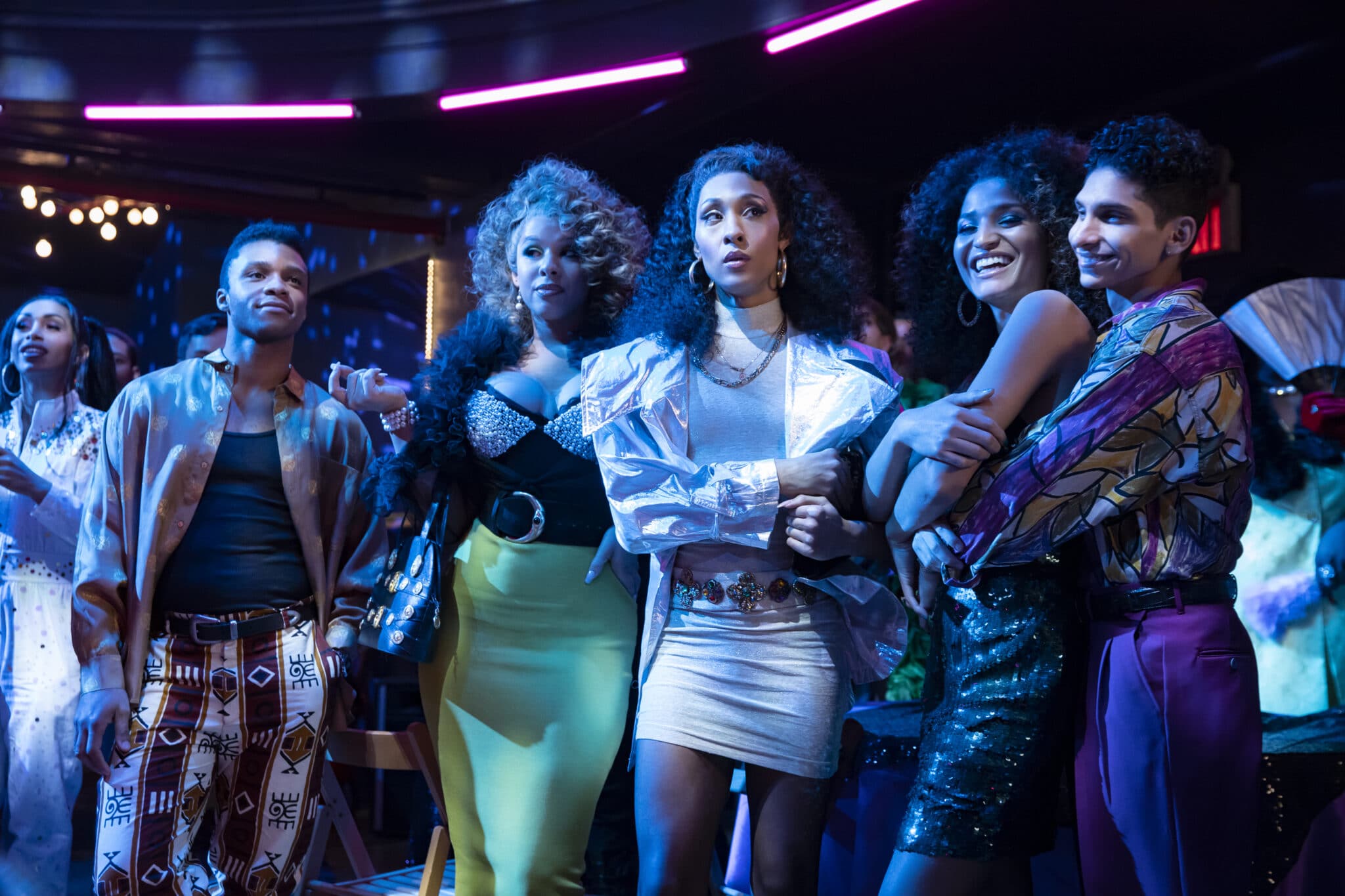
Dyllón Burnside as Ricky, Hailie Sahar as Lulu, Mj Rodriguez as Blanca, Indya Moore as Angel, Angel Bismark Curiel as Lil Papi. (Eric Liebowitz/FX)
In many ways, Pose changed the game when it came to HIV representation on screen. Audiences had grown used to watching predominantly white, almost entirely cisgender characters contracting HIV – so Pose was a much-needed breath of fresh air.
The powerful, trailblazing series follows Blanca (Mj Rodriguez), a trans woman and house mother as she navigates New York’s ballroom scene in the 1980s and 1990s. Throughout the show’s run, both she and Pray Tell (Billy Porter) are diagnosed with HIV.
The show depicts ACT UP protests and it explores the ingrained racism within the medical community that prevented Black people from accessing experimental treatments. The show’s powerful ending is both crushingly sad but also hopeful – it looks towards a brighter future for people with HIV and for queer people more broadly.
11. 2021: It’s a Sin
It’s a Sin landed on Channel 4 in January in what might have been the worst chapter of the coronavirus pandemic in many parts of the world – and it quickly crushed whatever last semblance of hope we might have had.
The five-part series follows Ritchie Tozer (Olly Alexander), Roscoe Babatunde (Omari Douglas), Colin Morris-Jones (Callum Scott Howells), Jill Baxter (Lydia West) and Ash Mukherjee (Nathaniel Curtis) as their lives converge in London in the 1980s.
However, their carefully crafted chosen family is quickly shattered by a mystery virus that is making its way through the queer community.
The series quickly won critical acclaim, while many praised it for bringing the story of the early days of the AIDS crisis to a new generation. The show was also significant for bringing queerness to the masses, and for its unflinching look at systemic homophobia.
What’s next?
You might have noticed a defining trait among these films and television shows – they all deal with the worst years of the AIDS epidemic in the 1980s and 1990s. Film and television writers have been most interested in confronting the worst traumas of the crisis – and it’s vital that those stories are told.
But it’s also important that audiences are given fresh stories about HIV told in the present day that show the impact the dawn of antiretroviral treatment has had. Today, effective medication means that a person with HIV can reduce their viral load to an undetectable level, meaning they can’t pass it on. It also prevents them from becoming sick, meaning they live long, healthy and happy lives. This scientifically proven fact is referred to as U=U.
We also have PrEP (pre-exposure prophylaxis), a medication designed to be taken daily that prevents a person from contracting HIV if they’re exposed to the virus.
Misinformation about HIV still abounds to this day – so many people don’t know the basic facts about the virus, such as how it’s transmitted, how it’s treated, and what the outlook is for people who are newly diagnosed today. Film and television writers could do with exploring some of those realities – and they could start showing people living well with HIV. We need more characters who are healthy and happy, and for whom HIV is just one part of their lives.
It’s also true that access to medication is far from equal, and minoritised groups are still among the worst affected. An estimated 680,000 people died from AIDS related illnesses last year alone, despite the fact that we now have medications that prevent people from developing AIDS.
Films and television shows have done a great job at depicting the early years of the AIDS crisis – now we need to start tackling the realities of living with HIV today.
